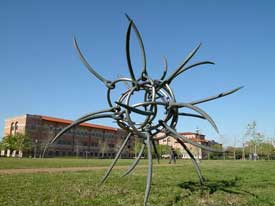Sculptor James Surls Puts A Magnificent Seven On The Rice Campus
by Hallie Jordan, Houston Press
James Surls, the sculptor who had seven of his art pieces installed at Rice University last

Photo by Hallie Jordan
month, enlightened a crowd there recently about his art philosophy and the ideas behind his plant-like sculptures.
The seven pieces in the exhibit, which arrived February 21, are entitled Magnficent Seven: Houston Celebrates Surls and reflect a connection with nature, featuring titles like “All Diamond,” “Ten Big Standing Bronze Flowers” and “Standing Vase With Five Flowers,” among others. Previous to their appearance in Houston, five of the seven pieces on display were exhibited on Park Avenue in New York.
The sculptures will remain at Rice until August 31.
During his lecture, Surls described his methods for making art and his beliefs about the connections between art and science.
“I think great science and great art have always gone together,” he said. “I think that between art and science, there is philosophy, which is the balance between the two.”
After working with Surls in the `80s on a public art project, Paul Hester, a Visual and Dramatic Arts Lecturer at Rice, said hearing Surls speak was particularly interesting. “My initial response was how different he looked,” Hester said. “As he said, he cut his hair, cleaned up his act and was much more mellow. In the past he was much more bombastic, he used to have a lot more swagger. I could still see that younger enthusiastic person, though.”
One of Surls’ pieces, “Knots and Needles,” describes how these two components have helped advance human capabilities, Surls said.
“Knots and needles gave us the ability to walk further, stay warmer and so many other things we could not do before,” Surls said. “The idea of the work is of the web of sewing, and thread and cloth, and what cloth did for us.”
Surls and Hester worked with DiverseWorks and four other artists to create public art for Market Square Park downtown. Surls made a metal based sculpture with wood flowers while Hester, a photographer, printed historic photographs on porcelain enamel.
“I told them I wanted my sculpture right in the middle of the park,” Surls said.
The park is currently being redesigned because the art was starting to need refurbishing and it became a hangout spot for homeless people, Hester said.
Surls also presented several drawings during his lecture and described their relation to his art.
“I get to have a piece of paper in front of me and pencil,” Surls said. “From there, I can search the universe. I love to draw. I think drawing historically will end up being pointed at as more important than anything else I do.”
Devin Glick, a Rice sophomore who attended the lecture, said hearing Surls speak really adds to his understanding of the sculptures.
“I thought it was interesting to see the personality behind the art,” Glick said. “It gives me a different perspective when I see them around campus now.”
Surls used his work, “Either or, You Choose”, 2005, to explain his drawing style and methodology.
“It is all done free hand,” Surls said. “Those oval shapes around those two worlds in the palms of the hands and around the undulating hair of this living thing is all done free hand. Ironically, the faster you do it the better it looks. If you do it slow, it will become zig-zaggy. It really works.”
Though Surls says his work could be referred to as abstract, he does not use the term.
“Maybe it’s because I grew up in East Texas. In East Texas, people say ‘Oh it’s abstract. I don’t have to know what that is.'”
Surls was born in Splendora, Texas and attended Sam Houston State University in Huntsville. Afterward, he taught at the University of Houston and worked at Lawndale Art Center upon its opening in 1979. After living in Texas for 50 years, Surls moved to Carbondale, Co. because his wife wanted to, he said.
“He was really thinking about the world from a different point of view,” Hester said. “His work when he lived in East Texas was not unlike it is now, but it was made out of wood. He would bring in whole trees and strip the bark. It was very much connected to where he lived. I’m wondering about this change from wood of metal. You can see his difference in location translated in his different materials.”
